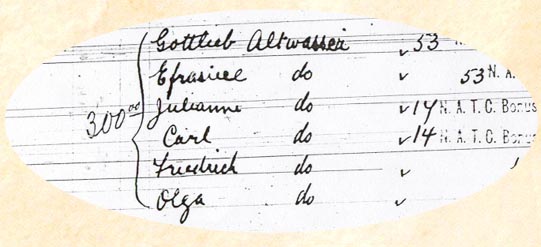| SS Dominion Sailing Record & Photograph |
The "Dominion" of 1899 was built in 1893 by Harland and Wolff of Belfast as the "Prussia" for the German Hamburg - America Line. She was a 5965 gross ton ship, length 445.5ft x beam 50.2ft, one funnel, four masts, twin screw and a speed of 14 knots. Accommodation for 60-1stclass and 1,800-3rd class passengers. She was launched on November 11, 1893 but her completion was delayed by a strike (they even had them in those days!) and she didn't leave Hamburg on her maiden voyage to Havre and New York until June 24,1894. She stayed on this service until her last voyage on February 6 1898 when she was sold to the British Dominion Line and renamed "Dominion". She was rebuilt with a tonnage of 6618 tons and accommodation for 200-1st, 170-2nd, and 750-3rd class passengers and commenced sailing Liverpool-Quebec-Montreal on May 7,1898. In 1908 she went to the American Line, was further altered to carry 370-2nd and 750-3rd class passengers and was put onto their Liverpool-Philadelphia service until May 1915. She did some intervening Dominion Line sailings and in 1918 did her first voyage after the Armistice from Liverpool to Portland on December 2, 1918. In the autumn of 1919 she was used as a cargo ship only and on February 26, 1921 she made her last trip from Liverpool to Portland and was scrapped in Germany in 1922. (North Atlantic Seaway by N.R.P.Bonsor, vol.1)
Description Source:
http://www.theshipslist.com/ships/descriptions/ShipsD.html
The SS Dominion
Sailed from Liverpool, England to Quebec
August 3 to August 12, 1905
Some notable passengers on this voyage.

Image from the SS Dominion;s passenger list, showing the names of Gottlieb Altwasser, his wife Euphrosine and their four children: Julianne, Carl, Friedrich and Olga.
The amount shown on the left side of the image was filled in by Canadian Immigration officials and indicates how much money the family had with them when the ship landed in Quebec City. Also, notice on the right side, there is a stamp saying "N.A.T.C. Bonus (Allowed)". It was a payment to the North Atlantic Trading Company for each agriculturalist it directed to Canada. Gottlieb's occupation was listed as a Farmer, Euphrosine as a Farm Wife, with Julianne and Carl listed as Farm Laborers. Friedrich and Olga were too young to be classified with an agricultural occupation, but as children of agriculturists, the bonus was allowed.
North Atlantic Trading Company (NATC):
A company contracted to find suitable immigrants, 1899-1910.
Definition Source
More About The N.A.T.C Bonus
Sir Wilfrid Laurier's Liberal government elected in 1896, immediately launched an aggressive campaign to encourage the settlement of Western Canada. Clifford Sifton, the Minister of the Interior in Laurier's government, offered land to people who chose to make the Prairies their home. To attract the farm labor needed to push back the Western frontier, he staged high-profile recruitment campaigns that employed methods that were not always new, but pursued more vigorously than had been done previously in advertising the West's attractions. A torrent of pamphlets in several languages flooded Great Britain, Europe, and the United States. Canadian exhibits were mounted at fairs, exhibitions, and public displays, while editorial articles, commissioned by his department, were inserted in foreign newspapers. Foreign journalists were wined and dined on guided tours across the West, and prosperous homesteaders were encouraged to revisit their homelands and those friends and relatives they had left behind, since it was Sifton's belief that the most effective advertising was done by individual contact.
One such campaign involved arrangements with an Amsterdam-based organization of booking agents and steamship company officials. In 1899, Clifford Sifton sanctioned a controversial contract with the NATC whereby the Company acquired a monopoly on all Canadian immigration promotional work throughout continental Europe and Scandinavia. Under the terms of the contract, the Company agreed to direct farmers to Canada, earning a bonus from the Immigration Department for each settler. The organization's operations were kept secret, allegedly because most European countries at the time had restrictive emigration laws and the agents involved were risking prosecution. When details of the government's secret agreement with the North Atlantic Trading Company were revealed in Parliament in July 1905, the opposition Conservatives bitterly condemned the scheme. Was there indeed such an entity as the NATC? If so, who were its officers? How much capital did it have? And from where did it do its business? There were few satisfactory answers to these and a myriad of other questions. Detractors believed the NATC to be a fraud, "raking-off" government funds for services not rendered and a rancorous debate ensued in the House of Commons. The North Atlantic Trading Company contract was cancelled, effective April 14, 1906. The issue had become too hot politically and continued probes into the NATC would have further embarrassed the government.
Frank Oliver, who succeeded Sifton as Minister of the Interior in 1905, continued Sifton's policy of paying booking agents to recruit suitable immigrants. In fact, not only was the policy retained, it was extended. Less than four months after the NATC contract was cancelled, the Department of the Interior had new immigration offices opened in Exeter, York, and Aberdeen and began to pay selected European booking agents a bonus for farmers, gardeners, carters, railway surfacemen, navvies (manual labourers building the rail lines without the benefit of machinery), and miners.
The following year, 1907, the Immigration Branch adopted an even more aggressive approach to immigrant recruitment, appointing 100 government agents and paying each one a two-dollar bonus for every British agricultural labourer recruited and placed in Ontario or Quebec. Two and a half million immigrants came to Canada between 1904 and 1913.
Source: http://www.cic.gc.ca/english/resources/publications/legacy/index.asp
 |
 |
 |
® Canada Copyright Registration No. 490341
to William J. Milner, March 8, 2001.